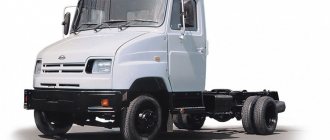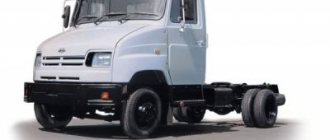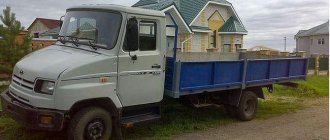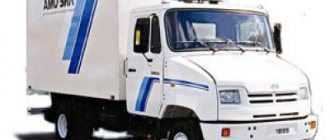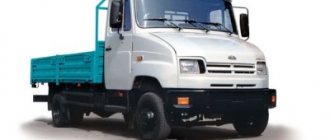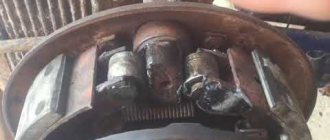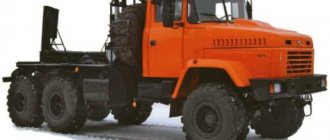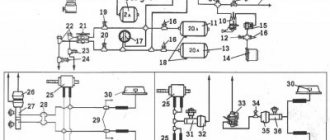ZIL 5301 is a domestic small-class truck produced by the Likhachev Plant. The prototype of the series was presented in 1991, but its production began only 4 years later. Over the course of 10 years, the model acquired many versions and firmly occupied its niche in the Russian market. The main advantages of the car were accessibility and simplicity of design.
ZIL 5301 received the nickname “Bull”. It arose as a response to the appearance of the Gazelle family from the Gorky Automobile Plant, which quite successfully entered the market several years earlier. Some sources associate the name with the former mayor of Moscow (Yuri Luzhkov), who supports the Likhachev Plant.
It is noteworthy that the ZIL 5301 series received the index by mistake. The industry standard at the time was that the first digit of the series should be “3.” Initially, no attention was paid to the inaccuracy, and then it was too late to change the name, since it was listed in the technological documentation. As a result, the 3-ton family received an index classifying it as a heavy cargo class.
PURPOSE
In technical terms, the ZIL 5301 turned out to be successful and was not inferior even to foreign competitors. A model was created for transportation within the boundaries of a region or city. However, there were special versions equipped with sleepers for long trips.
ZIL 5301 belongs to the segment of light-duty trucks. In comparison with analogues, the model looks quite compact, which allows you to feel comfortable in cramped urban environments. At the same time, the model with a carrying capacity of 3 tons confidently copes with its direct responsibilities - transporting large volumes of cargo.
Device
But domestic engineers examined the features of the structure and mechanism of German cars, and were able to remake them so that they met the needs of Russian drivers, could withstand the roads, and also adapt to the realities of the market. GAZ understood earlier what to do and launched production of light-duty Gazelle trucks and minibuses designed with Ford Transit in mind.
STORY
In the early 1990s, the Russian economy was experiencing a serious crisis. During that period, many enterprises lost markets and found themselves on the verge of collapse. The Likhachev plant faced similar problems. The medium-tonnage gasoline trucks produced by the company were not popular among consumers. Entrepreneurs needed small cars for transportation within the city. “Gluttonous” and outdated cars did not contribute to sales growth. After the reduction of government and military orders, production practically stopped.
The Gorky Automobile Plant got its bearings quite quickly and presented the compact Gazelle truck. At the Likhachev plant they decided to follow the same path and urgently launched a project to develop a fundamentally new delivery vehicle with a carrying capacity of 3 tons. Maximum unification with existing heavy trucks was considered as a priority. The prototype for creating the product was the Mercedes-Benz Vario. They decided to install proven elements from other models into the series: a type 130 box and a ZIL 4331 cab.
The ZIL 5301 series was launched in 1994. The main problem was the lack of a motor suitable for the new product. It was supposed to create several platforms and, on their basis, assemble trucks for specific orders. The flagship of the series was to be the classic “Bull.” To start production as quickly as possible, they began to use an automobile version of the D-245 engine as a temporary solution to the problem. As a result, the unit became the main one for the series. The first prototypes were presented at the end of 1994, and a year later a pilot batch of 219 trucks was produced. In 1996, mass production of the ZIL 5301 began.
In 1996-1997, a modular all-metal body platform appeared for the production of 2-, 3- and 4-section vans with a capacity of 10.5 to 20.5 cubic meters. Compactness and low loading height made it possible to develop cargo-passenger modifications based on the ZIL 5301 with a 6-seater cabin and a reduced cargo compartment. In 1998, a series of small ZIL 3250 buses (15- and 19-seater versions) entered the market.
“Bulls” were actively “attached” as government orders in various areas, which allowed the Likhachev plant to cope with difficulties. By 2000, the family's production volumes reached 12,300 units. The series showed good sales at the start, but gradually interest in the car began to decline. ZIL 5301 was losing to its main competitor GAZ 3310 Valdai and Chinese diesel trucks.
In the mid-2000s, in order to open the export of “Bulls” to the Eastern European market, it was decided to open a production site in Jelgava, Latvia. The car was supposed to be equipped with a Cummins diesel engine, modern disc brakes, a ZF transmission and a redesigned cabin. The export version had a carrying capacity of 4.5 tons. However, the project failed to be realized, and sales of the series continued to fall.
Initially, ZIL 5301 was equipped with diesel engines MMZ D-245.10, MMZ D-245.9 and MMZ D-245.12S (ecological class - Euro-0). Since 2005, the engine range has changed: all versions began to be equipped with the MMZ D-245.9 E2 (Euro-2) unit. After another 3 years, the engine was changed to MMZ D-245.9 E3 (Euro-3).
By 2008, production volumes had decreased to 527 units. The lack of a modern diesel engine and poor build quality negatively affected the popularity of the model.
At the end of 2011, production of ZIL 5301 was transferred from the main plant in the city of Petrovsk (Saratov region) to the Petrovsky auto parts plant AMO ZIL. However, the assembly line lasted only 3 years, after which the production of the model was completed. The outdated design, poor build quality and the emergence of more competitive successors caused a sharp drop in demand for the ZIL 5301. Despite the completion of production, the Bychok can still be found on the country's roads today.
Let's sum it up
The car had many advantages, which is why it was in great demand both from private carriers and from large companies. Over time, it was modernized, it became more environmentally friendly and easier to operate. If you compare the latest and first models, you can notice a significant difference in the quality of assembly and the operation of machine elements.
Considering the car’s considerable journey through changes and assembly line production, we can expect that in the future the model may acquire new data that will once again make the good old “Bull” one of the most popular light-duty vehicles.
We advise you to read the article: ZIL - the history of the auto giant
MODIFICATIONS
- ZIL 5301 – basic production version on the Mercedes-Benz platform, produced in a batch of 219 cars;
- ZIL 5301AO - onboard vehicle with a wheelbase of 3650 mm (1996-2001 production);
- ZIL 530104 – chassis for fire crews with a 2-row cabin;
- ZIL 530120 – reanimobile;
- ZIL 5301A1 (ZIL 5301A2/ZIL 5301A3) – cargo-passenger van;
- ZIL 5301BO – chassis for vans with a wheelbase of 3650 mm (1996-2001 model year);
- ZIL 5301VE – onboard version;
- ZIL 5301V2 (ZIL 5301V3/ZIL 5301V4) – chassis;
- ZIL 5301VA – chassis for vans with a wheelbase of 4250 mm and 2 sleeping places;
- ZIL 5301GO – chassis for isothermal vans with a wheelbase of 3650 mm;
- ZIL 5301GA – chassis for special superstructures with a wheelbase of 4250 mm and a 2-row cab;
- ZIL 5301DO – extended chassis for vans with a wheelbase of 4250 mm;
- ZIL 5301EO – chassis with a wheelbase of 4250 mm for special bodies;
- ZIL 5301EE – onboard modification;
- ZIL 5301E2 (ZIL 5301E3/ZIL 5301E4) – chassis;
- ZIL 5301ES – all-metal van with a wheelbase of 4505 mm;
- ZIL 5301IO – extended chassis for isothermal vans with a wheelbase of 4250 mm;
- ZIL 5301 - an onboard vehicle with a wheelbase of 4250 mm and an engine with a power of 130 hp;
- ZIL 5301K2 (ZIL 5301K4) – chassis;
- ZIL 5301ME – onboard vehicle;
- ZIL 5301M2 – chassis;
- ZIL 5301PO – chassis for isothermal vans with a wheelbase of 3650 mm;
- ZIL 5301RO – chassis for vans with a wheelbase of 4250 mm;
- ZIL 5301NS – van with a wheelbase of 3245 mm;
- ZIL 5301R1 – all-metal van with a 130-horsepower engine and a wheelbase of 3650 mm;
- ZIL 5301SS - all-metal van with a 108-horsepower unit and a wheelbase of 3650 mm;
- ZIL 5301TO – flatbed truck with a 2-row cab, the base for which was the ZIL 5301DO chassis;
- ZIL 5301CHA – tow truck;
- ZIL 5301YAO – flatbed version with a wheelbase of 4250 mm and 2 sleeping areas;
- ZIL 5301YUO - extended chassis for vans with a wheelbase of 4250 mm and a cabin equipped with 2 berths.
SPECIFICATIONS
Overall dimensions (main modifications):
- length (standard/extended version) – 6195/7165 mm;
- width – 2319 mm;
- height – 2365 mm;
- wheelbase (standard/extended version) – 3650/4250 mm;
- ground clearance - 180 mm;
- front track – 1832 mm;
- rear track – 1690 mm;
- turning radius – 7800 mm.
ZIL 5301 was equipped with an on-board platform. In the standard version it had the following parameters:
- length – 3750 mm;
- width – 2254 mm;
- height – 450 mm.
Other car characteristics:
- curb weight – 3695 kg;
- load capacity – 3000 kg;
- total weight – 6950 kg;
- front axle load – 2350 kg;
- rear load – 4600 kg;
- loading height – 765-1050 mm;
- maximum speed – 95 km/h;
- average fuel consumption at a speed of 60 km/h – 16 l/100 km;
- Tank capacity – 125 l.
Service intervals:
- first maintenance – 4000 km;
- second maintenance – 16,000 km.
Frame
One of the models of a light-duty truck from the Mercedes Benz concern called Vario was used as a prototype of the car.
The design of the frame was inherited from him - a ladder type, in which there are spars with a “channel” type section.
Such design features allow the Bull to be quite safe, since even in a head-on collision at high speed, the likelihood of the frame structure folding is minimal. The frame has the following overall dimensions:
- width – 845 mm;
- spar flanges (width) – 70 mm;
- The thickness of the metal from which the spar is made is 5 mm.
There is a special device in the front part of the frame that allows you to tow the car.
ENGINE
Over the entire period of its existence, the ZIL 5301 was equipped exclusively with one engine - the D-245 diesel engine (Minsk Motor Plant). The developers have repeatedly tried to use other units: Renault MIDR 040226F4 (136 hp), Bulgarian Vamo (120 hp) and CAT-3054 (135 hp), but the matter has not progressed further than experiments. The D-245 engine was modernized several times during the production of the series, receiving design changes and turbocharging. The environmental class has risen from Euro-0 to Euro-3.
Initially, MMZ D-245.10 (105 hp) units were installed on the ZIL 5301. Later, the D-245.12S (190 hp) and D-245.9 (136 hp) models appeared in the line. Since January 2005, the family has been equipped with D-245.9 E2 diesel engines, and since April 2008 - with D-245.9 E3 units with direct fuel injection. The latest version was distinguished by moderate fuel consumption, good traction qualities and met Euro-3 requirements. The motor allowed working with significant overload.
Characteristics of the D-245.9 E3 engine:
- working volume – 4.75 l;
- rated power – 100 (136) kW (hp);
- rotation speed – 2400 rpm;
- maximum torque – 460 Nm;
- number of cylinders – 4 (L-shaped arrangement);
- cylinder diameter – 110 mm;
- compression ratio – 15.1.
Transmission
“Bychok” is equipped with a 3-way 5-speed manual transmission with inertial synchronizers at all speeds. The cardan transmission is open with an intermediate support and a splined sliding connection. The transmission uses a 3.273 ratio hypoid final drive and a bevel gear differential. The drive axle is single-stage type. The clutch uses a single-disc dry friction system with peripheral springs.
Refill tanks
The car's refueling capacities are quite large, and this is justified by the engine power and its purpose:
- tank for filling washer fluid – 2.2 l;
- clutch (hydraulic) – 0.4 l;
- brake fluid – 1 l;
- power steering system - 3.2 l;
- the amount of oil in the shock absorber (true for any) – 0.45 l;
- gearbox (oil) – 5.1 l;
- rear axle (oil) – 3.3 l;
- cooling system capacity (to be completely filled) – 16 l;
- engine and radiator lubrication (total quantity) – 11.5 l;
- Fuel tank capacity – 125 l.
Find out what the prices are for Zhuk garden sprayers of different models. In our article you can understand the technical characteristics of the KamAZ-53215, as well as find out what equipment can be installed on its chassis.
By clicking on the following link https://spez-tech.com/tehnika/raznoe/kak-burit-skvazhinu-na-vodu-svoimi-rukami.html, you will find information about drilling a water well with your own hands, and you can also watch a video about this theme.
Brake system
The series is equipped with a brake system with pneumatic booster and dual-circuit hydraulic drive. The first circuit provides braking of the right front and left rear wheels, the second - the two remaining wheels. If problems arise with the circuits, emergency braking is performed via hydraulics. Disc brakes are used at the front, drum brakes at the rear. For the rear axle, brake mechanisms with automatic braking force control are used. The parking brake is driven onto the wheel pads of the rear axle. The latest modifications of the series also have an ABS system.
Cabin
To reduce the cost of developing the series, the creators used solutions previously tested on other cars of the Likhachev plant. The cabin became one of these elements, having “migrated” to the ZIL 5301 from the ZIL 4331 model. An unusual “tail” and expressive headlights were added as additions. There was a special 4-door version with 2 rows, designed for 6 people.
The Bychka cabin had many shortcomings typical of domestic cars of that period. Even at low speeds, the rumble of the engine could be heard in the cabin. Thermal and sound insulation were at a low level. In winter, working on the ZIL 5301 became very cold, despite the high efficiency of the stove. The paintwork was also considered a “sore spot” because it began to peel off within the first year of operation. Another flaw was the ventilation hatch, which leaked in many cars.
At the same time, the interior of the ZIL 5301 allowed us to work in comfort. The driver's seat had several settings and was soft. The upholstery was made of durable material that practically did not get dirty. The latest modifications received a cabin with improved thermal insulation, allowing operation in frosty weather. A large 2-spoke steering wheel with power steering ensured ease of maneuvers. The steering wheel was adjustable in height and angle.
Owner reviews about the ZIL-5301 “Bychok” car
Judging by numerous reviews, “Bychok” is generally a good car, subject to constant care and close attention to it. In this sense, ZIL-5301 is quite demanding. As one experienced “bull driver” put it, “if the owner himself drives the Bychka, then the car will make money, but if the driver drives it, then in a couple of months he will have to sell it.”
What none of the owners have any particular complaints about is the Minsk “Bychka” engine - reliable, high-torque, and economical in operation. With the carrying capacity, everything is more than normal: the car can easily “take on board” the “promised” three tons, and beyond this limit. A loaded ZIL-5301, according to the owners, “eats” about 20 liters of diesel fuel per 100 kilometers; empty - about 12. The transmission elements - the clutch and gearbox - also do not cause any problems during the entire period of operation, which are undoubtedly reliable and durable.
Cabin interior of ZIL-5301 “Bychok”.
The same cannot be said about the rear axle gearbox: it breaks, the greatest difficulties are caused by the differential side gears, crosspieces and satellites. The disadvantage that almost everyone talks about is the low quality of the metal. Unfortunately, the “Bychka” cabin quickly and uncontrollably corrodes and begins to “bloom” with rust already in the first years of operation. The cabin, however, is quite warm, spacious and comfortable. But it’s noisy, that’s a fact! Nothing yet for the end of the 20th century, but the noise and vibration protection of the driver’s workplace absolutely does not meet the standards of the 21st century.
Drivers like the ventilation hatch in the cabin, but it regularly leaks when it rains, and the high beams are ineffective. The engine compartment is cramped, not thought out, “you can’t get into anything.” It is felt that the D-245 engine was really considered as a “temporary measure”. Regarding the layout of other components, there are also rather politically incorrect statements from owners: “Whoever developed the rear brakes (fastening the pads and the handbrake) would have killed the reptile.”
Many owners call Bychok a “constructor for adults”: “As a result, after several years of working at Bychok, I became a top-class mechanic.” A lot of minor breakdowns and problems that arise regularly and periodically.
Anyone who is thinking about buying a used ZIL-5301 must have strong nerves, intelligence and “golden hands” (or urgently begin to “grow” them). However, all these troubles are compensated by the cheap price of the machine and its spare parts, its efficiency and profitability in operation.
Flaws
Among the main disadvantages of ZIL 5301 are:
- noisy engine that makes loud sounds even at idle;
- sunroof leaks (if equipped);
- low quality rubber, which breaks quite quickly under increased loads;
- regular breakdowns of the autonomous heating system installed upon request;
- increased sensitivity to low-quality fuels and lubricants;
- problems with starting in cold weather (typical for all versions);
- cracking of crosspieces and defects of differential gears on the rear axle.
Advantages and disadvantages
The clutch and gearbox cause virtually no problems and are perhaps the most reliable element. The rear axle gearbox breaks down much more often, where the greatest difficulties are caused by the differential side gears, crosspieces and satellites. The chassis also regularly causes inconvenience. Drivers are also advised to check the brake fluid level, since many modifications have reservoirs that leak and the protective covers installed on the brake calipers tear.
The interior of the cabin, as has already become clear, evokes conflicting emotions; on the one hand, the elements carry ergonomics, but on the other, their quality suffers greatly. One way or another, the simplicity of the design, reliability and maintainability made the ZIL-5301 “Bychok” a real people’s car.


